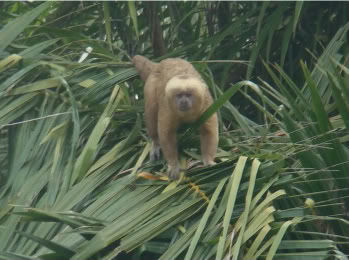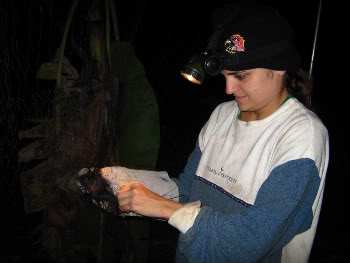Fourth in a series of interviews with participants at the 2009 Association of Tropical Biology and Conservation (ATBC) conference.
The Atlantic Forest may very well be the most imperiled tropical ecosystem in the world: it is estimated that seven percent (or less) of the original forest remains. Lining the coast of Brazil, what is left of the forest is largely patches and fragments that are hemmed in by metropolises and monocultures. Yet, some areas are worse than others, such as the Pernambuco Endemism Centre, a region in the northeast that has largely been ignored by scientists and conservation efforts. Here, 98 percent of the forest is gone, and 70 percent of what remains are patches measuring less than 10 hectares. Due to this fragmentation all large mammals have gone regionally extinct, while the medium and small sized mammals are described by Antonio Rossano Mendes Pontes, a professor and researcher at the Federal University of Pernambuco, as the ‘living dead’.
 Pontes with his students at a lab Christmas confraternization: he is in the center. Photo courtesy of Antonio Rossano Mendes Pontes. |
The threats to the region and its species are numerous: from widespread hunting to forest exploitation for burning wood and construction material, from a boom in sugarcane biofuels to poor governance. Behind all of this is extreme poverty and a lack of education, according to Pontes.
“Absolute misery and indecent salaries for the lowest classes […] prevent them from having access to the very basic daily items, such as animal protein, gas butane for cooking and other purposes, construction materials, and so on,” he says.
Despite the massive loss of habitat, the expiration of whole species, continued widespread hunting, and rampant exploitation of existing forests, the region still holds surprises. One of these was the blond capuchin: a Critically Endangered monkey species whose discovery was only announced to the world in 2006 by Pontes, who urged immediate conservation measure for the species.
But that’s not all. Since then Pontes and his team have found an unknown porcupine which is actually a new occurrence for the Genus Sphiggurus in that region and is most probably a new species for science. The discovery is the result of cooperation between Pontes, at the Universidade Federal de Pernambuco, and Dr Yuri Leite, from Universidade Federal do Espírito Santo, who is currently conducting DNA analysis. The find was sponsored by Conservation International under its Critical Ecosystems Partnership Fund. Pontes adds that there are several other mammals that may in fact by new species, but they are not yet ready to unveil.
However these discoveries of new species—already on the brink of extinction and possibly even the ‘living dead’—only show us how much we have already lost, according to Pontes, and what we will lose if urgent action isn’t taken in the region.
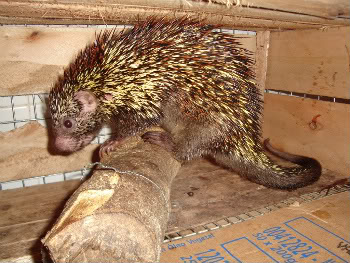 The possible new species of porcupine, Sphiggurus sp., collected with the appropriate licences and subsequently released in the forest. Photo courtesy of Antonio Rossano Mendes Pontes. |
“This entire catastrophe happened in obscurity, without being noticed or recorded. The large mammals were simply not there when we arrived, although past literature and reports from older local inhabitants refer to them: jaguars, pumas, giant ant-eater, white-lipped peccaries, tapirs, among many others, known and unknown,” Pontes says.
He envisions a time when the forest may only contain three mammals: common marmoset, squirrel and sloths. Most primates, porcupines, cats, and all other tantalizing rarities will disappear entirely.
“There are still many mammals living there, begging for a chance to survive—even species that we bet would not be there, such as jaguarundis, ocelots, the blond capuchin, and so on—and they deserve our greatest efforts to provide them with a better life, and possibly a less bleak future,” Pontes says
Pontes isn’t giving up on the forest. In order to save the species and the ecosystem he says that the first thing which is needed is round the clock patrols to prevent people from hunting animals and cutting down the forest. Next, he says the local population require attention, including sustainable livelihoods and environmental education.
“We can still save the CEPE, but we all have to wish to: local inhabitants, land-owners, politicians, decision-makers in general, and even children. If we provide nature with the minimum it will make the most of it and will reward us with blossoming life,” Pontes says, pointing out that with a tiny reforestation project (just 6 hectares) the blond capuchin population—the only recorded in the world—has gone from 30 individuals to 44, nearly a 50 percent bump.

The Critically Endangered blond capuchin. Here: An imposing sentinel adult male staring at Cássia, close to Mingú lake at Usina Salgado mill, State of Pernambuco. Picture by research student Cássia Rodrigues. |
Conservation for Pontes is a calling, both scientific and spiritual: “My heart (mind, actually) compels me to say that [we need to preserve nature] because it is God’s creation, because we need nature for our self-equilibrium, and because it is God’s cup from which we drink, but it is more than that”—and once more Pontes becomes the astute scientist: “I would mention just the most important: The Pernambuco Endemism Centre is unique, extremely biodiversity-rich, and mostly unknown, but because of lack of investment, mainly in biodiversity inventories and conservation alternatives, with most studies concentrating on other regions, such as south-east, we most certainly lost, and are losing unknown—and endemic—species, and with them, our ability to understand the evolutionary process that led to it.”
When asked about the future of the Pernambuco Endemism Centre in the Atlantic Forest, Pontes concludes that due to such high fragmentation and the loss of so many species there is no ‘future’, but in fact “the future is today”.
“This is most certainly the end of line, a scenario that announces that the [Pernambuco Endemism Centre] is about to vanish,” he says. “The future is today.”
In a September 2009 interview, Mongabay.com spoke with Antonio Rossano Mendes Pontes about his calling as a naturalist and conservationist; his new book; the continued destruction of the Atlantic Forest; possible conservation initiatives; new species, including the blond capuchin and the undescribed porcupine; the little-known olingo; and the future—if there will be one—for the Pernambuco Endemism Centre.
INTERVIEW WITH ANTONIO ROSSANO MENDES PONTES
Mongabay: What is your background?
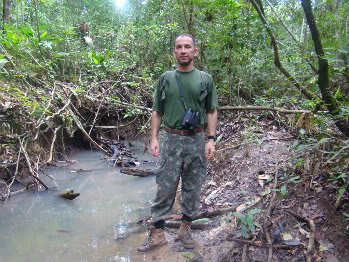 Pontes carrying out daily surveys of medium-sized mammals in one of our trails. Photo courtesy of Antonio Rossano Mendes Pontes. |
Antonio Rossano Mendes Pontes: In 1990 I finished a Biological Sciences course at the Federal University of Pernambuco (Recife, North-eastern Brazil), and got a job at the Federal University of Roraima (northernmost Brazilian Amazonia), which I am one of the founder members (stayed in Roraima between 1990-95).
In 1994 I got a scholarship from the British Council in Brazil to attend an M.Phil. course at Cambridge University, England, at the Wildlife Research Group, under the supervision of Dr David Chivers, whose first Brazilian student was famous conservationist Marcio Ayres (in 1995 I moved to the Federal University of Pernambuco, my mother University).
In 1996 I got a scholarship from the Brazilian National Research Council to do a Ph.D. in the same place at Cambridge University.
Mongabay: What drew you to working with mammals?
Antonio Rossano Mendes Pontes: I was always obsessed with knowing what the animals were doing in the jungle, and with the possibility of being with them without disturbing them. I remember various times when I was still a child and argued with my father because I wanted to get out of the car and go into the forest to see ‘what they were doing’. One day I saw news in a Brazilian magazine about the jaguar project then run by renowned conservationist George Schaller. I fell in love for jaguars and got in touch with George, we exchanged many letters and books, he took me to visit the project in the depths of the Pantanal forests at the age of 15, and I found out my vocation. I have since published the only article in literature on direct observations of jaguars and peccaries.
Mongabay: How did you become interested in the Atlantic Forest?
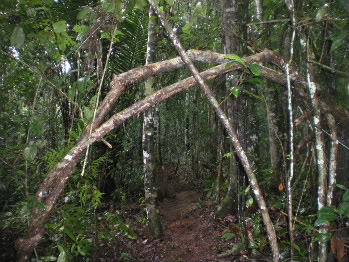 View of the study transect within Boca da mata, with a natural archway made of lianas. Photo courtesy of Antonio Rossano Mendes Pontes. |
Antonio Rossano Mendes Pontes: Forests are my heaven on earth. I need them in order to maintain my mind and my body in balance. The first thing that I did when I left the dry-scrub region where I grew up in the country-side of Northeastern Brazil, was to go into the Atlantic forest of Recife, at the Dois Irmãos Zoo, and I can still feel the emotion of the first contact, the smell of the forest, the coolness, and the eyes of the common marmosets staring at me curiously. I then looked for a project in which I could be trained in that forest, and with those lovely creatures, the common marmosets. In 1986 I was accepted in a project to study the ecology and behavior of the common marmosets in those forests of Dois Irmãos Zoo.
During this project I started witnessing the devastating impacts that human beings are inflicting on these absolutely neglected and unprotected forests. I decided that no matter where I would go, I would still do my little bit towards its conservation. I decided that I would not give up after I saw—all in the same place—huge intentional fires (that even destroyed my study area), slash-and-burn agriculture, trapping and slaughter of my beloved common marmosets and other mammals, dogs being sent to attack me, thieves using the forest as hiding place, invasion and cutting of trees by landless peasants, paths into the forest for caws and horses, and, of course, hunting in all its forms. I thought that I had to do something.
Mongabay: You recently wrote a book Amazonia and Other Forests of Brazil that describes your journey in becoming a naturalist and your work with various species throughout the Atlantic Forest, the Amazon, and the Pantanal. What made you decide to write this book?
Antonio Rossano Mendes Pontes: It is the materialization of a dream that I had since I first walked into the forests of Brazil and they started unveiling this fascinating world of nature to me. I wanted very dearly to show to the world the life that exists in the forest, how the animals live their ordinary life in such extraordinary ways, how lovely they are, and how magnificent is to be part of this luxuriant world. I also wanted to show to everyone how terribly bad we are treating our forests, their bleak future, and, through my experiences, adventures, life threats, and scientific findings reported in the book, I ultimately hoped to contribute to raise awareness and promote conservation. If I succeed in stimulating curiosity towards nature I will be happy. The book can be found at Blackwell (UK) , ABE (overseas) , among others. It will be available at amazon.com this coming fall.
STUDYING MAMMALS IN ONE OF THE WORLD’S MOST ENDANGERED FORESTS
Mongabay: You work in the northeast part of the Atlantic Forest: can you describe for us the state of this area, the Pernambuco Endemism Centre?
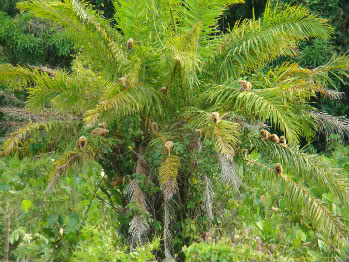 The study group of blond capuchin, (Cebus queirozi), feeding/resting in the most exploited of all tree species, the African palm, Elaeis guineensis (the dendê), where they sleep, feed, rest, socialize, among other activities, at Usina Salgado mill, State of Pernambuco. Picture by research student Cássia Rodrigues. |
Antonio Rossano Mendes Pontes: The situation today is beyond critical. We are witnessing the dawn of a hotspot’s hotspot. Imagine one ecosystem, of which only 2% remains and that among these remnants 70% are not more than 10 hectares and the single largest fragment is only over 3,000 hectares. All the fragments are totally isolated and immersed in a sugar-cane massive matrix, most are located on the top of high hills which were useless for sugar-cane (i.e. not representative of the various other micro-habitats that once existed), and the fragments are not at all pristine, but forest-border like. In this catastrophic scenario 50% of all trees have gone extinct. Coincidently, 50% of all medium-sized and large mammals (large such as jaguars, pumas, giant ant-eaters, white-lipped peccaries, tapirs, and so on) have gone extinct, and with them, the equilibrium of critical ecological processes that maintained a healthy forest, such as dispersion (tapirs alone disperse tons of small and large fruits). Most remaining medium-sized mammals live in abundances that are not at all sustainable in the long term, that is to say, they are the ‘living dead’. They will most probably disappear if this trend continues, and after all, if they manage to survive long enough, inbreeding will cause these unfortunate populations to disappear. Three species (common marmoset, squirrel and sloths) may be an exception to this, due to presenting comparatively higher abundances because of their smaller size and very generalist diet, combined with the absence of predators. Much has been discussed about how to save this critically-endangered ecosystem, but my daily experience in the jungle, to make it very plain, is of local people carrying on the exploitation of these forests, cutting trees and hunting what is left, unaware of the importance of its preservation. In one of our study sites, in only five nights (from only 18:00 p.m. to 01:00 a.m.), we heard 29 gun shots. Most of these forests are within private properties.
Mongabay: What are the main threats to the region?
 A southern tamandua, Tamandua tetradactyla, registered during nocturnal surveys near midnight in forest fragment Xanguazinho. Photo courtesy of Ramon Gadelha. |
Antonio Rossano Mendes Pontes:
1. Uncontrollable, widespread, continuous hunting, neglected by the authorities. We have recently conducted research on various forest fragments and found out that hunting occurs in all forest fragments, and we detected more hunting in the forest fragments that have relatively more animals.
2. Forest destruction for various reasons: (2.1.) selective cutting by local people who live below the poverty line, and have no choice but to exploit the forest resources; (2.2.) wood collection for celebrations, such as the ‘Saint John’ party, when most families in the entire CEPE make fires in front of their houses to celebrate. They either collect the wood themselves, or buy from various dealers on the streets (and this type of forest destruction has been neglected for centuries); (2.3.) to build houses and fences; (2.4) for sugar-cane; (2.5) for pasture; (2.6) for charcoal, just to name but a few.
3. Invasion of the remnants by landless peasants, who nowadays are a huge population, and by rural small settlers who want to extend their subsistence agriculture.
4. Inexistent or – in many cases – inefficient protection of forest fragments by owners of private forests. The forests are protected on paper, and the owners and their families may even intend to protect the forests, but the policy of protecting fragments is inefficient, and therefore, hunting and wood collection is widespread.
5. Isolation of the fragments and the consequent accidents with animals being run over by cars when they try to cross the roads to reach other forest fragments or the matrix of sugar-cane to forage and feed.
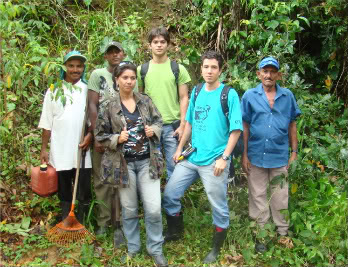 Pontes says: “Our dedicated group of field surveyors who together discovered the new porcupine: (clockwise): Field assistant Perereca, field assistant Xibiu (behind the lady), the porcupine discoverers research students Ramon and Éverton, field assistant Mr. Severino, and dedicated environment protection encharged, Miss Evânia”. Photo courtesy of Antonio Rossano Mendes Pontes. |
6. Mass extinction which has resulted in the simplification of the mammal community and suggests that the 21st century medium-sized mammal community of the CEPE will comprise only four species (out of ~35) that could survive in the smallest forest fragments of up to 10 hectares, which are: common marmoset, squirrel, sloth and agouti.
7. Irreversible genetic erosion because the animals have been isolated by hundreds of years: the damage may already have taken place – we just don’t know. Just to give you a typical sad example: in one of our study areas we have a single group of blond capuchins that live in a tiny forested area formed by three isolated small forest fragments that together comprises only 47 hectares, which, in some cases, force them to walk on the ground for some 150 meters. Whereas capuchins may use areas of up to 800 hectares in groups of less than 20 animals, this isolated group has nowadays 44 individuals crowded in this tiny area.
8. The most perverse type of loss, which is the loss of the unknown since we are losing species that are unknown to science or we did not know they occurred in the area. Twenty-three species of endemic birds have already been described, as well as one species of reptile, four species of butterflies, two species of gastropods, at least four species of amphibians, and at least 11 species of trees. I myself have shown to the world the critically-endangered blond capuchin, our group is describing a new porcupine [see below for photo], and we are in the way to describe a few more.
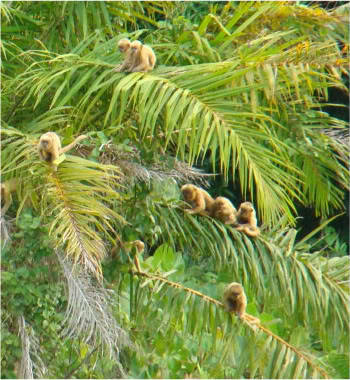 Close-up. With only 44 left in the world will these blond capuchins (Cebus queirozi) survive? Picture by research student Cássia Rodrigues. |
9. Lack of funds from the Government for research and conservation. The Federal and State Government would need to invest a lot more in biodiversity inventories and conservation projects. Current investments are minimal, and do not fulfill the need and urgency that the situation requires. For instance, since 2000 I have been working with my own savings and used my own (not 4×4) car (we still do not have a car), until this year Conservation International Brazil granted me some extremely valuable seed money for inventories, which has made a huge difference, and resulted in the discovery of a few species of medium-sized mammals that we did not know were there, one possibly new to science so far (we are looking at a few others), and made possible the understanding of the devastating impact that hunting has on the mammal assemblages.
10. The boom of biofuels (sugar-cane) is a new and immediate threat for the surviving forest fragments, because it is very likely that owners of the private properties which hold most of the remnants will be reluctant to expand and / or reconnecting the forest fragments, and even more reluctant to use part of the sugar-cane fields to do reforestation – little interest in a ‘little-profit’ activity. The Federal Government is very interested to present Brazilian biofuel as the solution for the petrol crisis, and will be supporting this expanding business in the name of the Brazilian economy.
11. Absolute misery and indecent salaries for the lowest classes which prevent them from having access to the very basic daily items, such as animal protein, gas butane for cooking and other purposes, construction materials, and so on.
Mongabay: What has happened to the large species of this highly fragmented forest?
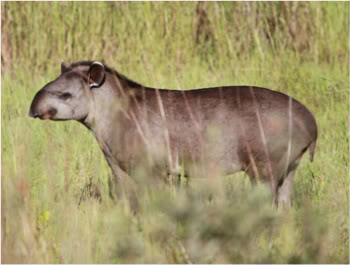 Tapir in Brazil’s Pantanal. A large mammal, the tapir no longer survives in the embattled Atlantic Forest. Photo by: Rhett A. Butler. |
Antonio Rossano Mendes Pontes: In the past (e.g. 500 years ago, before the colonization process first started) the forest matrix formed a continuum that maintained the equilibrium of the original ecological processes responsible for the maintenance of minimum viable animal populations. This should be understood as populations which are (1) viable for at least the next 500 to 1,000 years, or, (2) for at least 50 generations, that (3) would be able to maintain at least 90% of their heterozygous level, and that (4) would have at least 500 individuals. The c. 3.000 km² that remains of the Pernambuco Endemism Centre makes the maintenance of minimum viable populations of the medium-sized and large mammals virtually impossible, simply because there is not enough room for their populations. It is because the CEPE today is formed by very small and highly impacted forest fragments isolated in a matrix of agricultural fields, mainly sugar-cane, and because the “sink effect” is also taking place (e.g. the effect of losing individuals that are killed in the non-forest matrix when they try to cross it to reach another more favorable site).
Additionally, hunting has considerably speeded up the process. Even worse is that this entire catastrophe happened in obscurity, without being noticed or recorded. The large mammals were simply not there when we arrived, although past literature and reports from older local inhabitants refer to them: jaguars, pumas, giant ant-eater, white-lipped peccaries, tapirs, among many others, known and unknown. Being the largest implies a demand for larger areas, larger amounts of food, less abundance, longer birth intervals = lower reproductive rates, and, of course, larger animals provide more meat and more easily seen by hunters.
Mongabay: While working in this hyper-fragmented forest, you have discovered new species. Can you tell us about them?
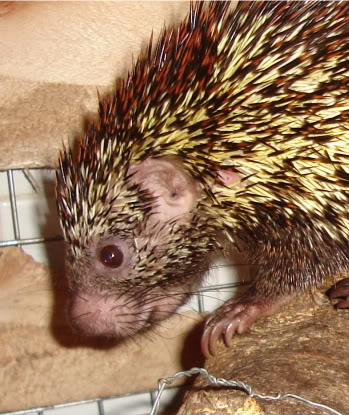 Close-up of the possible new species of porcupine, Sphiggurus sp., collected with the appropriate licences and subsequently released in the forest. Photo courtesy of Antonio Rossano Mendes Pontes. |
Antonio Rossano Mendes Pontes:
1. The blond-capuchin, Cebus queirozi, you can get the full story in the last chapter of my book!
2. A possible new species of porcupine, for which we are just about to submit a description.
3. All the others – which are quite a few, I am afraid you will have to wait!
Mongabay: What conservation efforts are being undertaken to save the Critically Endangered blond capuchin?
Antonio Rossano Mendes Pontes: I can only speak in the realm of my own scientific/conservation world: I have taken the very first step that anyone would towards the conservation of any endangered species, which is to understand their natural history, ecology and behavior in order to be able to set priorities. After more than 1,000 hours of direct observations of the group of blond capuchins we managed to understand a great deal of their terribly difficult life and bleak future. We as well managed to contribute to a little improvement, although significant, in their welfare. We were nevertheless unable to publish our findings—which could greatly contribute to their conservation—which I describe in my book.
In the larger scenario you have to ask the concerned authorities/decision makers. I can nevertheless say that my studies suggest that if we want to save this or any other species of medium-sized and large mammal of the CEPE we will have to carry out inventories of as many forest fragments as possible to determine their biological value and therefore, set priorities, re-connect and expand forest fragments, enhance their native food availability by re-introduction of the extinct (fruit) trees, and educate people and raise their livelihood, especially around the forest fragments, so that they are able to respect and protect nature. We have to reconsider the sacrifice of endangered species in hotspots, even more in hotspot’s hotspots such as the CEPE, and ultimately, re-introduce the extinct animal species to their habitat in order to restore the ecological processes. If all this is implemented, we can start thinking about long-term viable populations.
Mongabay: I have to ask what can you tell us about the little-known olingo, even though this is a little off topic since you studied olingos in the Amazon and not in the Atlantic Forest.?
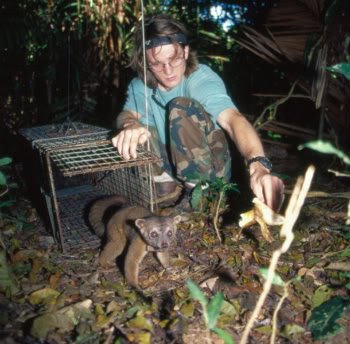
Top: Dr. Roland Kays (NYSM) offers an olingo a banana peace offering as it leaves a live-trap with a radio-collar in Limbo, Panama. Bottom: Close-up of the elusive and little-studied olingo. Photo credit: Marcos Guerra, Smithsonian |
Antonio Rossano Mendes Pontes: Olingos, Bassaricyon beddardi, from South America are almost totally unknown procyonids (coati-like species), except for the collection of a single individual in British Guyana by Pocock in 1895 and for my own long-term studies in Maracá island, Roraima State, Northernmost Brazilian Amazonia (or ‘adjacent Brazil’).
They are nocturnal creatures that live in the canopy of most forest types of Roraima, and despite being a carnivore (not a primate or a kinkajou) they eat a great deal of ripe fruit, and despite being said to be solitary animals, I found them both solitary and also in groups of up to 6 individuals, traveling and also feeding together. There was better chances to find them in groups when the nights were brighter—full moon—whereas they were more frequently seen alone when the night was more darker, which suggests that they have evolved to a social life due to protection against predation when they are more susceptible, that is to say, when they can be seen more easily by their predators.
During 1994, when I and my Macuxi indigenous assistant and guide, Antonio, found them, and followed them for 6 months, they were by far the most abundant nocturnal forest dweller, whereas their closest competitors, the night monkey, Aotus trivirgatus, and kinkajou, Potos flavus, were absent. In 1998 when I returned to Maracá for 2 years of field work, olingos had become less abundant, but were still there, at the same time night monkeys were now present in much more significant numbers. During 2006 when I returned again for three months, I could not find olingos, but registered a high abundance of night monkeys, similar to that of olingos during 1994. I still could not find kinkajous. This suggests that just over a decade there was a replacement of olingos by night monkeys in eastern Maracá, although olingos are heavier than night monkeys.
 Getting around isn’t always easy in the forest: Pontes’ car stuck on mud during field surveys at Usina Trapiche mill, Pernambuco. Photo courtesy of Antonio Rossano Mendes Pontes. |
During interviews I found out that non-native locals had a taboo related to olingos that say if hunters fall asleep in the tree while they are waiting for game to harvest, the olingos will come down from where they are, attack the hunter in the neck, and suck their blood until they die. Olingos are small cat-like carnivores, that are harmless, but have very bright eyes, and whenever they saw us in the forest they kept staring at us with great curiosity, sometimes even coming closer, which may be the reason for such a taboo.
This shows how awfully little we know of our forests and how badly we need scientists and conservationists studying these areas so that before any decisions can be taken we know what the biological value of these areas are.
Mongabay: If conservation measures aren’t taken immediately what do you think the Atlantic Forest will look like in 25 years?
Antonio Rossano Mendes Pontes: The CEPE today has 13,619 forest fragments of up to 10 hectares, which is 70% of all the forests left, and the mean size of the forests within this size class is only 2.8 hectares, all formed by secondary highly modified border-like forests. Only the four already mentioned species of medium-sized mammals can live there (common marmoset, squirrel, sloth and agouti), but in most fragments not even all the four species occur (sometimes only one of them, and sometimes none of them). This is most certainly the end of line, a scenario that announces that the CEPE is about to vanish. The future is today.
CONSERVATION OF THE FOREST
Mongabay: Why is it important to conserve these areas of the Atlantic Forest?
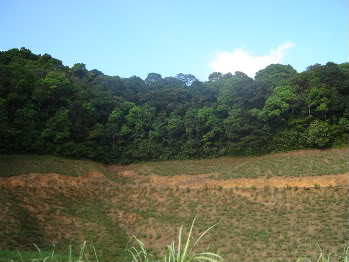 View of the border of the forest fragment boca da mata (94 ha). Pontes and his students found common marmosets, sloths and two species of porcupines living here. Photo courtesy of Antonio Rossano Mendes Pontes. |
Antonio Rossano Mendes Pontes: My heart (mind, actually) compels me to say that it is just because it is God’s creation, because we need nature for our self-equilibrium, and because it is God’s cup from which we drink, but it is more than that. I would mention just the most important: the Pernambuco Endemism Centre is unique, extremely biodiversity-rich, and mostly unknown, but because of lack of investment, mainly in biodiversity inventories and conservation alternatives, with most studies concentrating on other regions, such as south-east, we most certainly lost, and are losing unknown—and endemic—species, and with them, our ability to understand the evolutionary process that led to it. As Carnaval et al recently published in Science, this sector of the Atlantic forest has been a refuge for biodiversity during late Pleistocene due to much higher climatic stability, revealing a hotspot within a hotspot, with a much higher genetic diversity compared to other areas. As shown by Reeder et al in the Texas Museum journal, the number of new species discovered throughout the centuries has increased steadily, and if the CEPE is as unique as we predict, this therefore reinforces our predictions. Last, but not least, there is still many mammals living there, begging for a chance to survive—even species that we bet would not be there, such as yaguarundis, ocelots, the blond capuchin, and so on—and they deserve our greatest efforts to provide them a better life, and possibly a less bleak future.
Mongabay: Do you believe it is simply too late to save this forest and its wildlife?
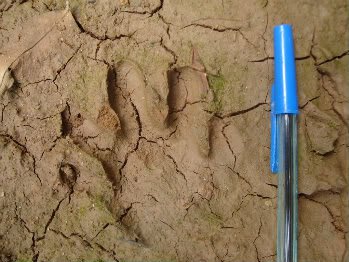 : Footprint of a crab-eating racoon, Procyon sp. (footprints are a main source of information about the scarce fauna living in the region). Photo courtesy of Antonio Rossano Mendes Pontes. |
Antonio Rossano Mendes Pontes: Not at all. We can still save the CEPE, but we all have to wish to: local inhabitants, land-owners, politicians, decision-makers in general, and even children. If we provide nature with the minimum it will make the most of it and will reward us with blossoming life. I will give you a wonderful example: the group of blond capuchins that we are now studying had around 30 individuals at the time of their discovery in 2006 then the owners of the Usina Salgado where they live decided to start a reforestation program around their home range, and reforested a tiny piece of bare land of approximately 6 hectares. After two years the animals started using this additional area to exploit the resources and, much to our amazement, a new counting revealed that the group had increased to 44 individuals.
Mongabay: If the forest and the species were to be saved what would need to be done?
Antonio Rossano Mendes Pontes: If we want to save at least what is left, we have to take urgent action bottom-up. Instead of discussions on highly-elaborated strategies, making alliances at high-levels, and proposing theoretical scenarios that we know we will not be able to implement, we are signing the death sentence of this hotspot. What we have to do to save what is left, and is absolutely urgent, is the simplest of the measures: to install effective 24 hour patrolling posts close to the forest fragments to avoid the most effective way to destroy these forests, selective cutting and hunting. The government has to impose such patrols also on private properties, which most of the fragments are. But the government has failed to do this in an effective manner because it requires investment.
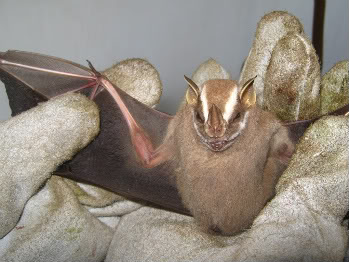
Top: Brazilian big-eyed bat (Chiroderma doriae) from the CEPE. Bottom: Carla Nobre, a research student in a capture-recapture nocturnal survey with mist nets. Photo credit: Carla Clarissa. |
If we manage to stop selective cutting and hunting in the remaining forest fragments, we can move on to improve the livelihoods of the local people and environmental education (knowing that we will have the time to wait until better livelihood and environmental education shows results). We can then think about restoration and re-connection of the forest fragments and forest archipelagos, essential to prevent population isolation, and also to increase the forest areas available, and therefore, make it possible for the populations to return to minimum viable populations.
Mongabay: Is there support from locals for conservation measures in the area?
Antonio Rossano Mendes Pontes: Local people around the forests are totally unaware of the importance of preserving the forest fragments and the animals. They are hungry and have more immediate things to care about, such as survival. In fact, they hunt to survive and extract forest resources in an unsustainable manner, mainly wood for house purposes (building, cooking, fencing, etc). They show a total lack of knowledge on how to behave towards nature, which is a mere consequence of not having environmental education. In fact they are mostly illiterate and can barely sign their names, and even those that have permanent or temporary jobs live below the poverty line. Children play in their backyards dragging around green iguanas held in a very tight string that will invariably lead to death; with a ‘baleadeira’ (meaning hitter) made of a y-folk wood stick and elastic used to throw stones and kill birds, lizards; and building traps to catch any unfortunate animal that fall victim, and so on, and see no harm in this. School teachers in the region have very little knowledge, miserable salaries, and therefore teaching is precarious and with little or no mention of environmentally-related issues.
 The ‘baleadeira’. |
Mongabay: How about from the national or local government?
Antonio Rossano Mendes Pontes: In my opinion, little effort has been made to save this hotspot’s hotspot, otherwise there would not be just 2% left. In the last decades, nevertheless, the national, and especially the local government has increased considerably the investments in biodiversity, but it is still far from what we would need in order to effectively save this hotspot from vanishing completely. Federal and State government have to create museums in the region devoted to inventories; alternatives towards sustainable use of the biological resources and conservation; permanent environmental education centers where teachers, students, and the society in general could be trained, and especially, teachers that could take education and training to the far and poorer corners of the country where the most needy people live.
We need more professionals in the area, but despite the amount of resources having increased every year, we still have a limited number, for instance, of scholarships for undergraduate students, e.g. although I and most of my colleagues having dozens of students under scientific initiation, we seldom get more than one scholarship every year from the National Research Council (CNPq / PIBIC). We still have a very limited number of post-graduate scholarships, and only a small percentage of the candidates get a place in the post-graduate courses. The same could be said of project proposals, since only a few receive money (e.g. I myself was never compensated with money for my biological inventories notwithstanding my various applications to work in the CEPE, publications and discoveries).
They could also promote the decentralization of knowledge providing incentives for highly-qualified professionals of all fields to go to the far corners of the country, where they could provide training to the locals for a period of time and contribute to local development. This could be an exchange between post-graduate students and the government.
We have The National Environment Office (IBAMA) and also other institutions responsible for the protection of the environment, but the rationale between number of employees and area to be patrolled is ridiculous, which demands the admission of many more guards for protection to be efficient. During daily life in the jungle nothing has changed. The locals continue hunting and collecting wood as their ancestors did centuries ago. The forests continue to shrink to give room to sugar-cane and pasture, and species are disappearing.
Mongabay: What can people do to help?
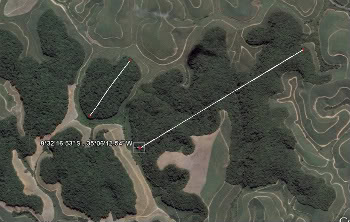 Two of the forest fragments Pontes and his team used to survey mammals at the Usina Trapiche mill in Pernambuco State, Pernambuco Endemism Centre (the white lines are the exact location of the trails, open in a straight line with the help of a GPS). Photo courtesy of Antonio Rossano Mendes Pontes. |
Antonio Rossano Mendes Pontes: People must not trap animals to have as pets, must not keep them in jails, and never buy them in the illegal open markets. They must call the related authority whenever they find animals kept outside their natural environment and pet markets at least to make sure that it is not an illegal situation.
They must start finding alternative materials to wood, such as steel and concrete, and always demand a certificate of origin of the wood that they buy. Owners of bakeries and pizzerias must stop buying wood to feed their furnaces for cooking and find alternatives.
People should start to change their attitude towards the celebration of the three religious days of June: Saint Anthony, Saint Joseph and Saint Peter, when they build open wood fires in front of every catholic house to celebrate the birth of so-called Saint Baptist. These fires are normally between 1 and 2 meters high, but in some cases could reach up to 20 meters high depending on the enthusiasm and faith of the believer. The wood for this purpose is all taken from the remaining forest, and, of course, illegally.
Parents must prevent their children from using animals when they play (such as trapping, promoting cruelty, and keeping them), and whenever they find them doing so, they should not only free the animal or take it to a care center, but explain to their children the importance of respecting and preserving nature.
Mongabay: How do you stay positive working in an ecosystem where you are literally watching species go locally extinct year by year?
 Gervais’s fruit-eating bat (Artibeus cinereus) from the CEPE. Photo credit: Carla Clarissa. |
Antonio Rossano Mendes Pontes: It is devastating to realize that species have gone locally or regionally extinct, such as some species that the natives swear they have seen, and we are unable to find—species that they describe, which we suspect are different from anything we have ever seen, but are no longer there. I nevertheless stay positive because a steady change is perceptible. Since the ECO 92 all sectors of the Brazilian society have been more and more aware of the importance of conservation. I consider it a matter of time until things turn more and more efficient and we can see real results. We are progressing.
To give you a few practical examples: I have managed to establish highly effective bilateral cooperation between our University and some sugar mill landowners through which we advise them on sustainable use of biological resources and conservation of fauna and flora and they provide infra-structure, meals, and even seed money for us to carry out pure and applied scientific research into their properties in the forest fragments that they preserve. They have even started reforestation projects before we started working together. These are the cases of the Usina Salgado, where we found the blond capuchin, Cebus queirozi, and Usina Trapiche, where we found a new porcupine, Sphiggurus sp. nov. As you can realize each of these cooperations resulted in a great contribution to science and conservation.
Mongabay: It is apparent from your book that your faith has been an important part of your journey toward becoming a scientist and conservationist. Can you tell us about this?
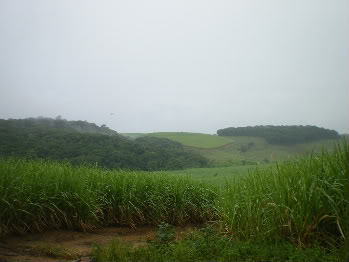 Forest fragments. Photo courtesy of Antonio Rossano Mendes Pontes. |
Antonio Rossano Mendes Pontes: I was born with a great inherent faith in God and also a great love and obsessed interest in nature. The combination of these feelings shaped my professional life. At the same time I can work, delight myself, as well as love and respect nature. I cannot remember a single day of hard work in the jungle (and I can walk up to 25 kilometers a day searching and following the large mammals) in which I did not stop for a few seconds to thank God for the moment of absolute completeness and for His mercy for allowing me to be there every day admiring something new from His greatest creation.
How can faith and love precisely contribute to daily life in the jungle? I have had some transcendental experiences in the jungle which helped me to overcome great difficulties (and I describe these experiences in the book), but the more real benefits of faith and love for nature are the power and strength that it brings whenever I most need it. Whenever I get to the border of the forest just before starting work (better described as my ‘hobby’) I am taken by a deep desire to accomplish things and understand nature that makes me fear nothing or no one.
If you would like to reach Antonio Rossano Mendes Pontes, please e-mail him: mendespontes@gmail.com
Related articles
Brazil may ban sugarcane plantations from the Amazon, Pantanal
(09/18/2009) Brazil will restrict sugarcane plantations for ethanol production from the Amazon, the Pantanal, and other ecologically-sensitive areas under a plan announced Thursday by President Luiz Inacio Lula da Silva’s administration, reports the Associated Press.
Golden lion tamarins play key role in seed dispersal in Brazil’s Mata Atlantica
(08/10/2009) Golden lion tamarins play an important role in seed dispersal in Brazil’s Mata Atlantica, report researchers writing in the the journal Tropical Conservation Science.
Destruction of Brazil’s most imperiled rainforest continues
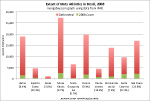
(05/31/2009) More than 100,000 hectares of Brazil’s most threatened ecosystem was cleared between 2005 and 2008, reports a study by the Fundação SOS Mata Atlãntica and the National Institute for Space Research (INPE). The “Atlas of Mata Atlântica Remnants”, released May 26, assessed the extent of the Mata Atlântica (Atlantic Forest) across 10 of the 17 states where the coastal rainforest occurs. It found that an 102,938 hectares were destroyed during the three year period. The annual loss of 34,121 hectares per year was 2.4 percent lower than the 34,965 ha recorded from the 2000-2005 period.
Brazil moves to protect and restore endangered Atlantic rainforest
(11/22/2008) Brazilian president Luiz Inacio Lula da Silva has signed a decree to protect and restore critically endangered rainforest along the country’s Atlantic coast, reports the Associated Press.
A billion trees to be planted in Brazil’s Atlantic Forest over the next 7 years
(04/22/2008) A billion trees to be planted in the Atlantic Forest over the next seven years. The Nature Conservancy has begun a program to plant a billion trees in Brazil’s dwindled Atlantic Forest. The Atlantic Forest used to cover Brazil’s long coast, but today only seven percent of the forest remains. Both the megacities of Sao Paulo (the world’s fifth largest city) and Rio de Janeiro have emerged and grown in what used to be tropical forest. Yet, the forest remaining retains an incredible bio-diversity much of it endemic.

(01/10/2008) The Atlantic forest of Brazil boasts South America’s largest primates, the Southern and Northern Muriqui. The muriqui are unique among all primates, because they are not territorial and do not display aggressive behvaior. The IUCN has classified the Southern Muriqui as endangered, while the Nothern Muriqui is critically endangered. Dr. Karen Strier has studied the Northern Muriqui in the field for twenty-five years. A professor of zoology and anthropology at the University of Madison Wisconsin, she is the author of Faces in the Forest: the Endangered Muriqui Monkeys of Brazil and a new textbook entitled Primate behvaioral Ecology.
Brazil’s threatened Atlantic forest may be more resilient than thought
(09/06/2007) The Atlantic forest of Brazil, one of the world’s most threatened biodiversity hotspots, may have served as a critical refuge for biodiversity during the ice ages. The findings suggest that despite being reduced to just 8 percent of its original extent due to agriculture and urban expansion, the Atlantic forest may be capable of recovery. In other words, the Atlantic forest may be more resilient to change than previously believed.
New monkey species found in Brazil claims scientist
(05/19/2006) Brazilian scientist claims to have discovered a previously unknown species of monkey, although other experts say the species may have been documented before. Earlier this month, Antonio Rossano Mendes Pontes, a professor of Zoology at the Federal University in Pernambuco, published a scientific description of Cebus queirozi in the international scientific journal Zootaxa. The primate — which may weigh 6 1/2 pounds when full grown — has long golden-yellow fur and a white cap on the front half of its head.


